Enumerate the parts of small intestine.
Small intestine is about 6 m long and is divided into 3 parts: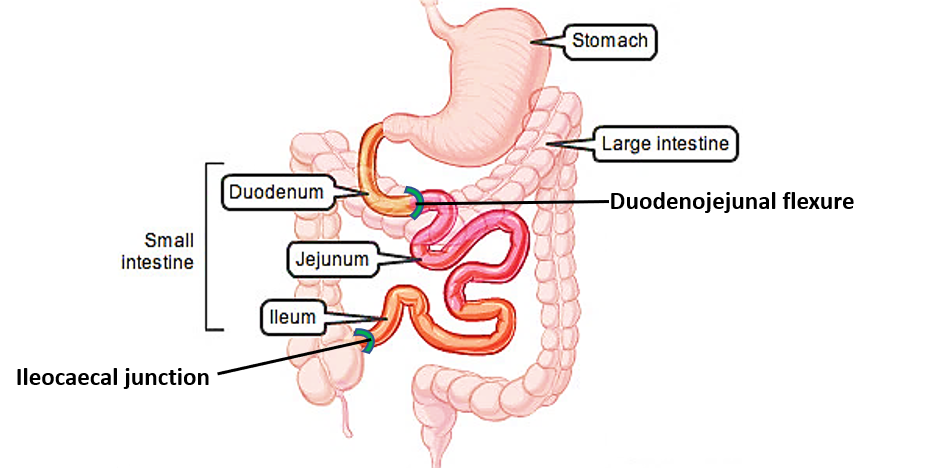
- Duodenum
- Jejunum
- Ileum
The duodenum is the proximal fixed part and mostly retroperitoneal. The other parts, i.e., jejunum and ileum are freely mobile and are encosed in peritoneal fold called mesentery.
Jejunum and ileum extend from duodenojejunal flexure to the ileocaecal junction.The upper 2/5th is jejunum and the lower 3/5th is the ileum. However, there is no clear line of demarcation
What are the differences between jejunum and ileum?
Following are the differences between Jeunum and Ileum:
Feature Jejunum Ileum Location Usually occupies umbilical region Occupies hypogastric and pelvic regions Length Proximal 2/5 th of small intestine except duodenum Distal 3/5 th of small intestine Caliber Wider Narrower Wall thickness Thicker Thinner Vascularity More vascular Less vascular Plicae circulares Closely set Widely separated Peyer’s patches (aggregated lymphoid follicles) Scanty Numerous
Differences in mesenteryDistribution of fat Less More Number of arcades February 1, 2018 April 3, 2018 Vasa recta Longer and fewer Shorter and numerous
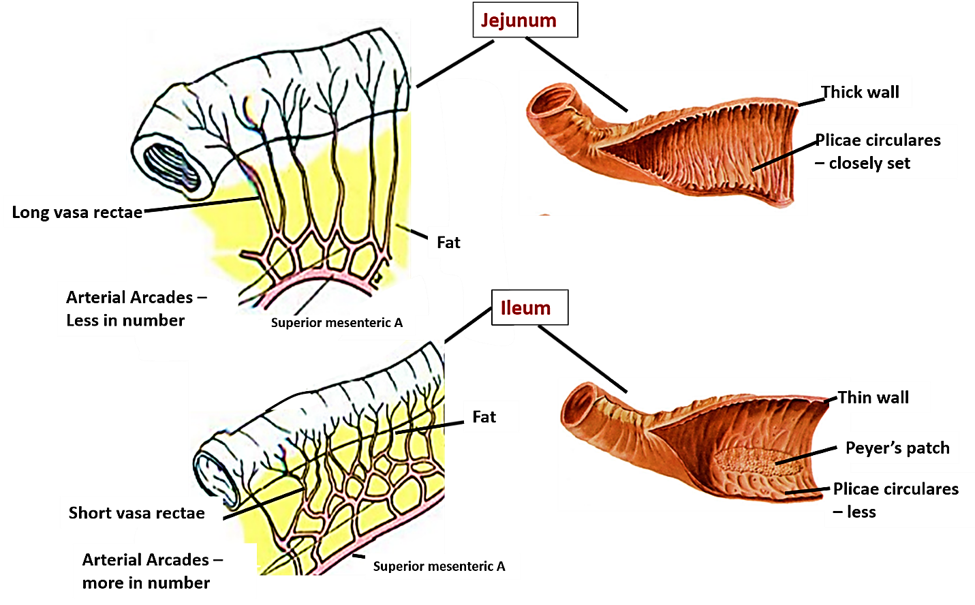
What is mesentery? Enumerate the structures crossed by the root of mesentery.
Mesentery
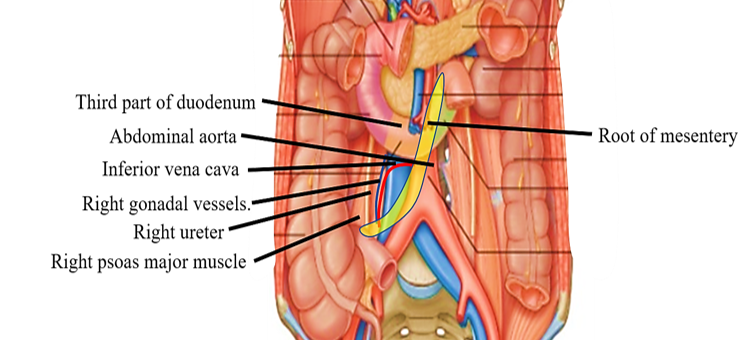
- Mesentery is a fan shaped fold of peritoneum that suspends jejunum and ileum from the posterior abdominal wall.
- Its attached margin (to posterior abdominal wall) is called root of the mesentery.
- The root is approx. 15 cm. long.
- It extends from the left side of the L2 vertebra to the right sacroiliac joint.
Structures crossed by the root of the mesentery from above downwards are:
- Third part of duodenum
- Abdominal aorta
- Inferior vena cava
- Right gonadal vessels.
- Right ureter
- Right psoas major muscle.
What are the contents of mesentery?
Following are the contents of mesentery:
- Coils of jejunum and ileum
- Jejunal and ileal branches of superior mesenteric artery
- Mesenteric lymph nodes
- Intestinal lymph vessels
- Nerve plexus
- Extraperitoneal loose connective tissue
- Fat
Describe the arterial supply of jejunum and ileum.
Superior mesenteric artery, a branch of abdominal aorta supplies jejunum and ileum.
- 12-15 jejunal and ileal arteries arise from the left side of superior mesenteric artery to supply jejunum & ileum..
- Within the mesentery they branch and anastomose to form arterial arcades from the terminal arcades vasa recta arise that supply jejunum and ileum.
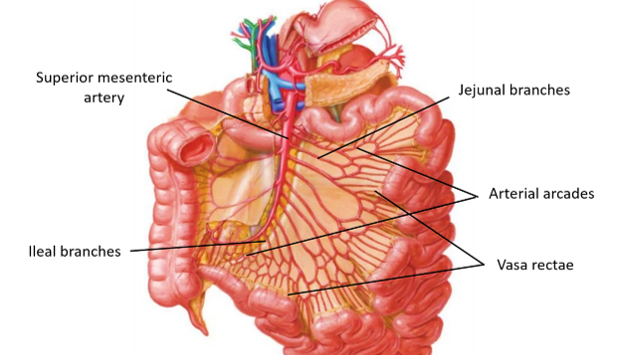
Describe in brief the nerve Supply of jejunum and ileum.
Small intestine is supplied by autonomic nervous system.
- Sympathetic nerve supply: from T10-T11 spinal segments. Are vasomotor.
- Parasympathetic nerve supply : from vagus nerves. It stimulates peristalsis.
Applied Aspects
Meckel’s diverticulum
- Is a blind diverticulum from the antimesenteric border of ileum.
- Is located about two feet from ileocaecal junction.
- Is a remnant of proximal part of vitellointestinal duct.
- Is usually 2 inches long.
- Occurs in 2% of population.
- It may contain ectopic gastric mucosa or pancreatic tissue.
- Can be a site of peptic ulcer.
- May cause intestinal obstruction.
- When inflamed , symptoms mimic those of appendicitis.
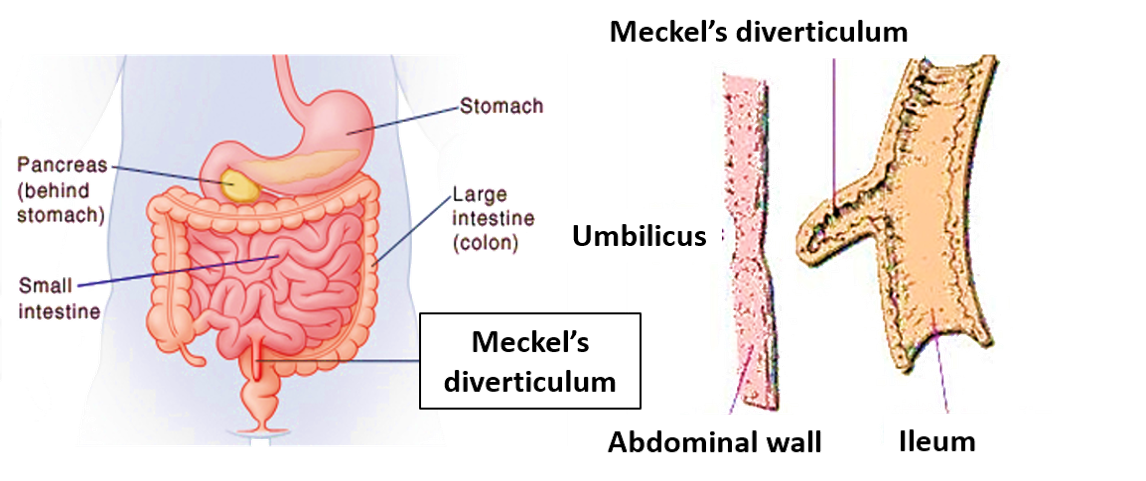
Peyer’s patches
Peyer’s patches are located along the antimesenteric border of the ileum. They may ulcerate in typhoid fever and after recovery these ulcers don’t cause intestinal obstruction like tubercular ulcers. This is because, the tubercular ulcers are circular and therefore, after recovery they may cause constriction of the lumen of small intestine by fibrous tissue, whereas the typhoid ulcers are longitudinal.
